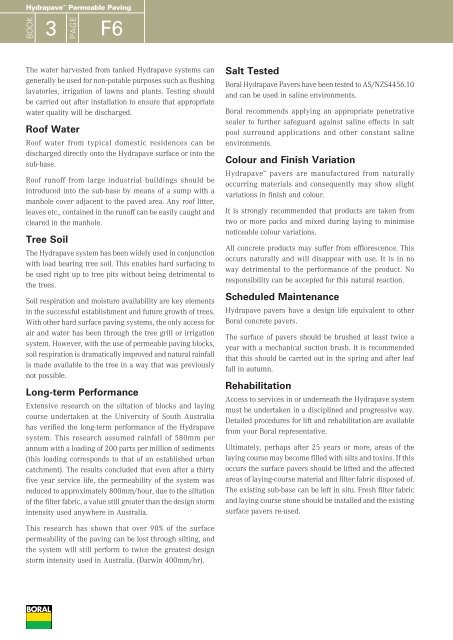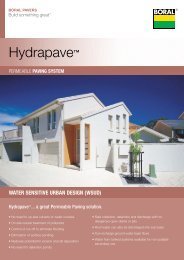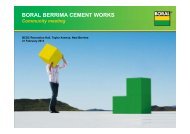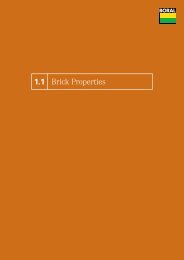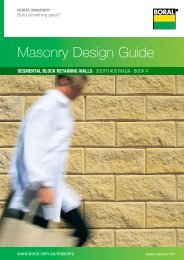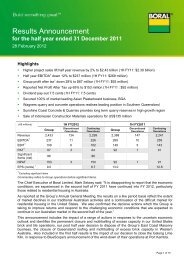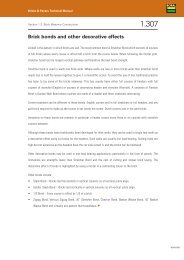Specifications and additional Information - Boral
Specifications and additional Information - Boral
Specifications and additional Information - Boral
You also want an ePaper? Increase the reach of your titles
YUMPU automatically turns print PDFs into web optimized ePapers that Google loves.
Hydrapave Permeable Paving<br />
BOOK<br />
3<br />
PAGE<br />
F6<br />
The water harvested from tanked Hydrapave systems can<br />
generally be used for non-potable purposes such as flushing<br />
lavatories, irrigation of lawns <strong>and</strong> plants. Testing should<br />
be carried out after installation to ensure that appropriate<br />
water quality will be discharged.<br />
Roof Water<br />
Roof water from typical domestic residences can be<br />
discharged directly onto the Hydrapave surface or into the<br />
sub-base.<br />
Roof runoff from large industrial buildings should be<br />
introduced into the sub-base by means of a sump with a<br />
manhole cover adjacent to the paved area. Any roof litter,<br />
leaves etc., contained in the runoff can be easily caught <strong>and</strong><br />
cleared in the manhole.<br />
Tree Soil<br />
The Hydrapave system has been widely used in conjunction<br />
with load bearing tree soil. This enables hard surfacing to<br />
be used right up to tree pits without being detrimental to<br />
the trees.<br />
Soil respiration <strong>and</strong> moisture availability are key elements<br />
in the successful establishment <strong>and</strong> future growth of trees.<br />
With other hard surface paving systems, the only access for<br />
air <strong>and</strong> water has been through the tree grill or irrigation<br />
system. However, with the use of permeable paving blocks,<br />
soil respiration is dramatically improved <strong>and</strong> natural rainfall<br />
is made available to the tree in a way that was previously<br />
not possible.<br />
Long-term Performance<br />
Extensive research on the siltation of blocks <strong>and</strong> laying<br />
course undertaken at the University of South Australia<br />
has verified the long-term performance of the Hydrapave<br />
system. This research assumed rainfall of 580mm per<br />
annum with a loading of 200 parts per million of sediments<br />
(this loading corresponds to that of an established urban<br />
catchment). The results concluded that even after a thirty<br />
five year service life, the permeability of the system was<br />
reduced to approximately 800mm/hour, due to the siltation<br />
of the filter fabric, a value still greater than the design storm<br />
intensity used anywhere in Australia.<br />
This research has shown that over 90% of the surface<br />
permeability of the paving can be lost through silting, <strong>and</strong><br />
the system will still perform to twice the greatest design<br />
storm intensity used in Australia. (Darwin 400mm/hr).<br />
Salt Tested<br />
<strong>Boral</strong> Hydrapave Pavers have been tested to AS/NZS4456.10<br />
<strong>and</strong> can be used in saline environments.<br />
<strong>Boral</strong> recommends applying an appropriate penetrative<br />
sealer to further safeguard against saline effects in salt<br />
pool surround applications <strong>and</strong> other constant saline<br />
environments.<br />
Colour <strong>and</strong> Finish Variation<br />
Hydrapave pavers are manufactured from naturally<br />
occurring materials <strong>and</strong> consequently may show slight<br />
variations in finish <strong>and</strong> colour.<br />
It is strongly recommended that products are taken from<br />
two or more packs <strong>and</strong> mixed during laying to minimise<br />
noticeable colour variations.<br />
All concrete products may suffer from efflorescence. This<br />
occurs naturally <strong>and</strong> will disappear with use. It is in no<br />
way detrimental to the performance of the product. No<br />
responsibility can be accepted for this natural reaction.<br />
Scheduled Maintenance<br />
Hydrapave pavers have a design life equivalent to other<br />
<strong>Boral</strong> concrete pavers.<br />
The surface of pavers should be brushed at least twice a<br />
year with a mechanical suction brush. It is recommended<br />
that this should be carried out in the spring <strong>and</strong> after leaf<br />
fall in autumn.<br />
Rehabilitation<br />
Access to services in or underneath the Hydrapave system<br />
must be undertaken in a disciplined <strong>and</strong> progressive way.<br />
Detailed procedures for lift <strong>and</strong> rehabilitation are available<br />
from your <strong>Boral</strong> representative.<br />
Ultimately, perhaps after 25 years or more, areas of the<br />
laying course may become filled with silts <strong>and</strong> toxins. If this<br />
occurs the surface pavers should be lifted <strong>and</strong> the affected<br />
areas of laying-course material <strong>and</strong> filter fabric disposed of.<br />
The existing sub-base can be left in situ. Fresh filter fabric<br />
<strong>and</strong> laying course stone should be installed <strong>and</strong> the existing<br />
surface pavers re-used.


